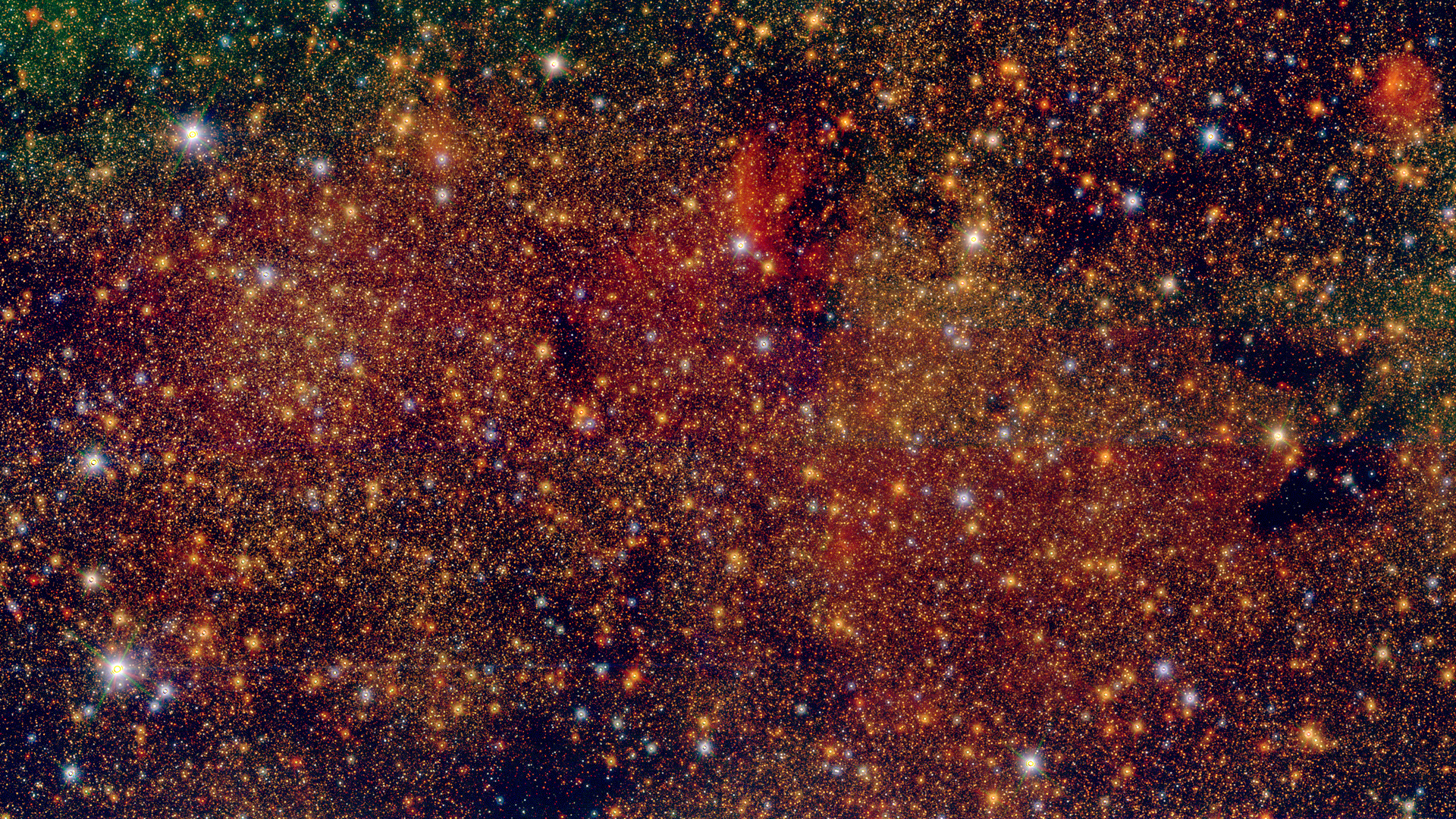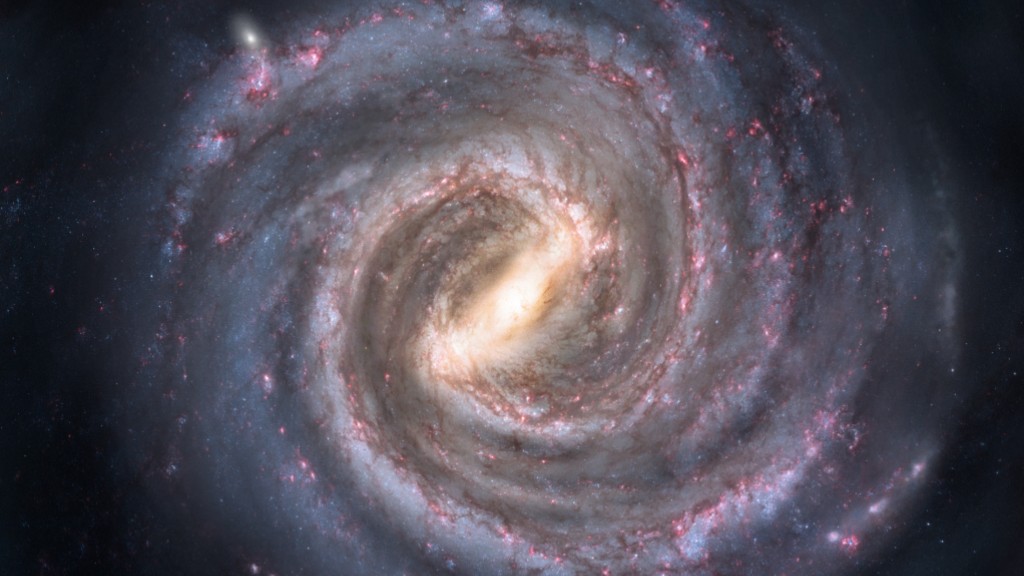'Star factory' at Milky Way's heart seen for the first time
New results indicate that star formation in our galaxy radiated out from its core as young stars drifted apart.

Astronomers have reconstructed the history of star formation at the center of the Milky Way for the first time, finding that starbirth radiated outwards from the galaxy's heart.
The results also revealed that most young stars in the densely packed galactic center formed with only loose associations and drifted further apart over the course of millions of years.
Using the HAWK-I infrared camera of the Very Large Telescope (VLT) located in Chile, astronomers conducted the GALACTICNUCLEUS survey, studying an area of 64,000 square light-years around the galactic center in greater detail than ever before.
Despite the fact that a dense population of stars exists at the heart of the Milky Way — roughly 26,000 light-years from Earth — only a small fraction of these stars have been observed thus far.
Related: 4 big Milky Way mysteries the next Gaia mission data dump may solve
By tracing some of the region's missing stellar mass and collecting data for 3 million stars, the researchers were able to study the qualities of those young stars for the first time.
"Our study represents a big step forward in finding the young stars in the galactic center," Max Planck Institute for Astronomy researcher and research team member Francisco Nogueras-Lara said in a statement. "The young stars we found have a total mass of more than 400,000 solar masses. That is nearly ten times higher than the combined mass of the two massive star clusters that were previously known in the central region."
Get the Space.com Newsletter
Breaking space news, the latest updates on rocket launches, skywatching events and more!
The team's findings — which contradict previous ideas that stars at the center of our galaxy formed in tightly packed clusters — could help scientists better understand rapid star formation as seen in the early history of the universe and in the so-called 'starburst galaxies.'
In terms of mass, the Milky Way forms new stars at a rate of just a few times that of the sun each year. Starburst galaxies, on the other hand, produce tens or even hundreds of solar masses per year. This rapid star formation occurs in bursts lasting a few million years — relatively short time periods on a cosmic scale.
This high star formation rate is thought to have been common in galaxies when the 13.8-billion-year-old universe was around 4 billion years old.
The low star-formation rate of the Milky Way hasn't stopped astrophysicists from using it to investigate starbirth in other galaxies, thanks to the central region of the galaxy.
Around 1,300 light-years from the Milky Way's central supermassive black hole — Sagittarius A* (Sgr A*) — star formation rates are ten times higher than in the rest of our galaxy and have been so for the past 100 million years.
This means the core of the Milky Way is a fitting proxy for starburst galaxies, or even for the galaxies of ten billion years ago.

Star formation at the galactic center
In order to observe the central region of the galaxy, astronomers still must account for several challenges. Firstly, the thick dust in the Milky Way's disk obscures our view of the galaxy's core.
One way of dealing with this is to make observations in infrared, millimeter, or radio wavelengths at which light can pass through the dust.
Even after this problem is addressed, the fact that the galactic center is so densely populated means that, for all but the most massive stars, astronomers have difficulty distinguishing one star from another.
This means that while observations of ionized hydrogen — created when ultraviolet light from hot young stars rips electrons away from atoms — have confirmed that rapid star formation is happening at the heart of our galaxy, the stars produced as a result of this have been tough to spot.
Until these new findings, astronomers had only been able to locate around 10% of the stellar mass predicted to dwell around Sgr A*. This mass content has been contained in two massive star clusters and a smattering of isolated stars.
The VLT is composed of a series of 26-foot (8 meters) telescopes, meaning a technique called holographic imaging which combines several short-exposure images, can be used in order to eradicate the blurring effects of Earth's atmosphere on the images of the galactic center.
This allowed the astronomers to examine the area in fine detail which revealed that a region called Sagittarius B1 contains many more young stars than previous observations had shown.
Evidence of 'inside-out' star formation
Though the team was only able to study some of the most massive stars in Sagittarius B1, they were able to discover each star's brightness and luminosity — the amount of light a star emits over a certain period of time.
By examining the statistical distribution of stellar luminosity for the stars and sorting them into a 'brightness bracket' the researchers could trace their lifetimes, how many stars were formed at what time, and thus the evolution of star formation in the galactic center.
The researchers also found that the stars in Sagittarius B1 are not part of a massive cluster, but are more dispersed. This indicates that the stars were formed in loose associations which have dissolved over millions of years as they circle the heart of the Milky Way.
While this dispersal was spotted in observations of Sagittarius B1 in particular, it could explain why only high-resolution studies like GALACTICNUCLEUS have been able to spot young stars which have dispersed at the center of the Milky Way.
The team also found that Sagittarius B1 and the innermost regions of the galactic center are populated with older stars — above the age of 7 billion years — while there is a shortage of stars aged between 2 and 7 billion years. This may show that star formation at the center of the Milky Way began in its innermost areas and then radiated outwards.
A similar 'inside-out' process has been previously observed in other galaxies and is key to the creation of a small disk of stars surrounding a central region, called a 'nuclear disk.'
Nogueras-Lara and the team will now follow up on these observations with another VLT instrument, a high-precision spectrograph called the K-band Multi-Object Spectrograph (KMOS).
By studying the light of the Sagittarius B1 stellar population directly and by using spectrography to assess their composition, the researchers should be able to individually identify some very young stars.
Astronomers will also track the rapid motion of the newly-located Sagittarius B1 stars around the galactic center over several years, watching how their position in relation to one another changes. This could help better understand how the stars were grouped earlier in their existence.
"Both kinds of measurements will serve to hopefully confirm, but definitely refine, the results of the now-published work," Lise Meitner Group-leader at the Max Planck Institute for Astronomy, Nadine Neumayer, said in the statement. "At the same time, we and our colleagues will start exploring what the new insights into star formation in the Galactic Center can tell us about high-productivity star formation in other galaxies."
Follow us on Twitter @Spacedotcom and on Facebook.
Join our Space Forums to keep talking space on the latest missions, night sky and more! And if you have a news tip, correction or comment, let us know at: community@space.com.

Robert Lea is a science journalist in the U.K. whose articles have been published in Physics World, New Scientist, Astronomy Magazine, All About Space, Newsweek and ZME Science. He also writes about science communication for Elsevier and the European Journal of Physics. Rob holds a bachelor of science degree in physics and astronomy from the U.K.’s Open University. Follow him on Twitter @sciencef1rst.









